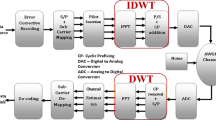Abstract
WiMAX is a coming forth broadband wireless technology that considered as one of the most prominent solution to provide high speed data services. This paper addresses the design of WiMAX end to end physical layer (PHY) in Simulink with channel equalization and space time block coding techniques. The authors analyzed the performance of WiMAX PHY with decision feedback equalizers (DFE), linear equalizers and blind equalizers over AWGN and multipath faded channels. Results include MISO channel power spectral density (PSD), antenna amplitude/PSD/phase difference, multipath faded and AWGN channel’s effect on the transmitted signal and the performance of proposed equalizers on the received signals. This paper concluded that the linear equalizers have higher frame error rates (FER) than DFE. However, blind equalizers have higher FERs compared to conventional equalizers with better spectral efficiency as they need no training sequence.













Similar content being viewed by others
References
Sampei, S. (1997). Applications of digital wireless technologies to global wireless communications. New York: Prentice Hall PTR.
Andrews, J. G., Ghosh, A., & Muhamed, R. (2007). Fundamentals of WiMAX: Understanding broadband wireless networking. New York: Pearson Education publications.
Dahlman, E., Parkvall, S., & Skold, J. (2013). 4G: LTE/LTE-advanced for mobile broadband. London: Academic Press.
Zhu, H., & Wang, J. (2012). Chunk-based resource allocation in OFDMA systems :Part II: Joint chunk, power and bit allocation. IEEE Transactions on Communications, 60(2), 499–509.
Poutanen, J., Salmi, J., Haneda, K., Kolmonen, V., & Vainikainen, P. (2011). Angular and shadowing characteristics of dense multipath components in indoor radio channels. IEEE Transactions on Antennas and Propagation, 59(1), 245–253.
Huang, Y.-C., Tunali, N. E., & Narayanan, K. R. (2013). A compute-and-forward scheme for gaussian bi-directional relaying with inter-symbol interference. IEEE Transactions on Communications, 61(3), 2704–2712.
Burse, K., Yadav, R. N., & Shrivastava, S. C. (2010). Channel equalization using neural networks: A review. IEEE Transactions on Systems, Man, and Cybernetics, Part C: Applications and Reviews, 40(3), 352–357.
Merched, R. (2013). A unified approach to reduced-redundancy transceivers: Superfast linear and block-iterative generalized decision feedback equalizers. IEEE Transactions on Signal Processing, 61(17), 4214–4229.
Gong, M., Chen, F., Yu, H., Lu, Z., & Hu, L. (2013). Normalized adaptive channel equalizer based on minimal symbol-error-rate. IEEE Transactions on Communications, 61(4), 1374–1383.
Özen, A., Kaya, I., & Soysal, B. (2012). A supervised constant modulus algorithm for blind equalization. Wireless Personal Communications, 62(1), 151–166.
Alamouti, S., & Tarokh, V. (2011). Transmitter diversity technique for wireless communications, Google Patents, US Patent 7,916,806, mar ’29’.
Yang, D., Xu, C., Yang, L.-L., & Hanzo, L. (2011). Transmit-diversity-assisted space-shift keying for colocated and distributed/cooperative MIMO elements. IEEE Transactions on Vehicular Technology, 60(6), 2864–2869.
Gulati, K., Evans, B. L., Andrews, J. G., & Tinsley, K. R. (2010). Statistics of co-channel interference in a field of poisson and poisson–poisson clustered interferers. IEEE Transactions on Signal Processing, 58(12), 6207–6222.
Otaru, M. U., Zerguine, A., & Cheded, L. (2011). Channel equalization using simplified least mean-fourth algorithm. Digital Signal Processing, 21(3), 447–465.
Leung, S.-H., & So, C. F. (2005). Gradient-based variable forgetting factor RLS algorithm in time-varying environments. IEEE Transactions on Signal Processing, 53(8), 3141–3150.
Karimi-Ghartemani, M., & Iravani, M. R. (2002). A nonlinear adaptive filter for online signal analysis in power systems: Applications. IEEE Transactions on Power Delivery, 17(2), 617–622.
Beres, E., & Adve, R. (2007). Blind channel estimation for orthogonal STBC in MISO systems. IEEE Transactions on Vehicular Technology, 56(4), 2042–2050.
Chen, Z., et al. (2003). Performance of Alamouti scheme with transmit antenna selection. IEEE Electronics Letters, 39(23), 1666–1668.
Zhang, Y., & Ge, S. S. (2005). Design and analysis of a general recurrent neural network model for time-varying matrix inversion. IEEE Transactions on Neural Networks, 16(6), 1477–1490.
Yuan, J.-T., & Lin, T.-C. (2010). Equalization and carrier phase recovery of CMA and MMA in blind adaptive receivers. IEEE Transactions on Signal Processing, 55(4), 3206–3217.
Khan, M. N., & Sabir G. (2008). The WiMAX 802.16 e physical layer model, IET international conference on wireless, mobile and multimedia networks.
Vaughan-Nichols, S. J. (2004). Achieving wireless broadband with WiMax. Computer, 37(6), 10–13.
Author information
Authors and Affiliations
Corresponding author
Rights and permissions
About this article
Cite this article
Reddy, B.S.K., Lakshmi, B. Improvement in the Performance of WiMAX with Channel Equalizers and Space Time Block Coding Techniques Using Simulink. Wireless Pers Commun 84, 2815–2833 (2015). https://doi.org/10.1007/s11277-015-2768-5
Published:
Issue Date:
DOI: https://doi.org/10.1007/s11277-015-2768-5




